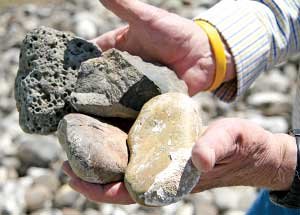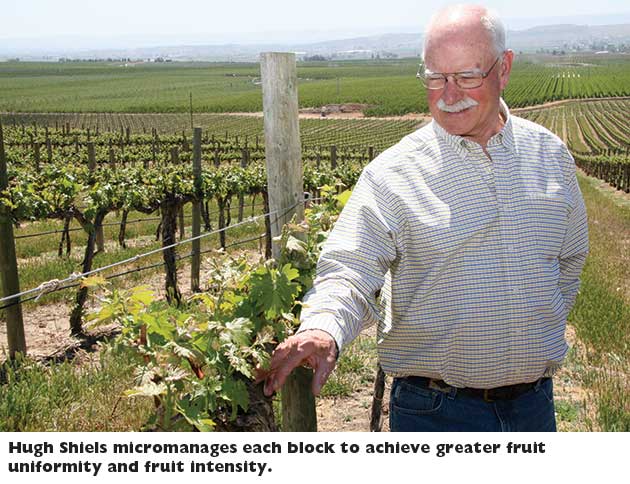
These four types of rocks found in DuBrul Vineyard each tell a different story about the region’s geologic influences.
photos by Melissa Hansen
Geology is an important part of what makes a wine appellation unique and distinct. The Yakima Valley American Viticultural Area was influenced by several geological wonders, all which can be observed at DuBrul Vineyard.
As you drive up the dirt road leading to the top of the 45-acre DuBrul Vineyard located along the eastern side of the Yakima Valley near Sunnyside, Washington, you can’t miss seeing a big pile of rocks. But these aren’t just any rocks.
“These are rocks with a story,” said Hugh Shiels, owner of DuBrul Vineyard and Côte Bonneville winery. “The rocks tell a story about the geology of the Yakima Valley AVA.” The appellation, Washington State’s first AVA, is celebrating its thirtieth anniversary this year.
Hugh and Kathy Shiels purchased an apple orchard in 1991 and began converting it to a vineyard the following year. The rock pile, there when they bought the land, contains the kind of rocks that excite geologists like Kevin Pogue of Whitman College’s geology department.
Pogue has toured the DuBrul Vineyard and combed through the rock pile to find several types of rocks, including granite and ancient quartzite, basalt, igneous rocks from the Ellensburg Formation, and others.
According to an article written by Pogue, Yakima Valley’s story begins 15 million years ago when molten lava flows covered eastern Washington and solidified into a 13,000-foot blanket of basalt. The weight of the basalt depressed the Earth’s surface and created the Columbia Basin.
The next influence was the ancestral Columbia River. The Columbia once flowed through the Yakima Valley, depositing granitic rocks from the Canadian Rockies, igneous rocks from the Ellensburg Formation (rocks formed from Cascade volcanic ash and sediments mixed with basalt), and other rocks and sediment.
The course of the river changed when tectonic upthrusts created Rattlesnake Hills and Horse Heaven Hills and diverted the Columbia River eastward to the Wallula Gap. Lastly, when Glacial Lake Missoula built up behind an ice dam some 15,000 years ago and flooded Montana, Idaho, and eastern Washington, its floodwaters backed up into the Yakima Valley and deposited more rocks and sediment.
Pogue’s description of Yakima Valley AVA’s geologic influences can all be witnessed at DuBrul Vineyard. The basalt promontory that the vineyard is planted on, combined with the flood-borne rocks and wind-blown loess and volcanic ash, has created low-vigor soils important to premium wine grape production.
World class

DuBrul Vineyard, named after Shiels’s wife’s family, was planted in 1992 and now includes six varietals—Cabernet Franc, Cabernet Sauvignon, Syrah, Merlot, Chardonnay, and Riesling.
About 25 percent of the fruit is used for Côte Bonneville’s estate wines, the Shiels family winery. The rest is sold to more than a dozen wineries.
From the vineyard’s start, he envisioned a world-class wine grape vineyard. “My goal is about fruit intensity,” he explained. “I want my fruit to be intense and be made into wines that are supple, elegant, and appeal to consumers.”
He enlisted expert viticulturists and consultants to help him with vineyard layout, variety selection, trellis design, irrigation, vineyard development, and daily management. Shiels is an orthopedic surgeon in Sunnyside, and though he’s practicing only a few days a week these days, in the 1990s he worked full-time hours.
The vineyard is on a steep, south-facing slope (1,300 feet in elevation at the top), which gives good sun exposure and provides air drainage on three sides. It’s a warm microclimate in what’s generally considered to be a cooler wine grape growing region.
Both whites and reds do well there, but in carefully chosen locations of the vineyard. For example, Chardonnay was initially located at the top of the vineyard, but the variety struggled to grow enough canopy. It’s been replaced with Cabernet Sauvignon, which does well in the warmer location. The Chardonnay was moved to a lower elevation on the hill.
Syrah, a vigorous variety, does particularly well in his rocky soils, and the long but cool growing season of the Yakima Valley allows the variety to fully ripen without losing acidity.
Micromanager
Shiels micromanages each row of the vineyard, depending on soil variation and water need of the vines. Each row has two drip lines—one for irrigation, one for fertigation. Valves strategically placed along the drip irrigation lines allow him to irrigate each row in segments and apply different amounts of water within the same row.
He manages the trellis and canopy on a block-by-block basis, making alterations for the same variety planted in different locations. Crop load is adjusted for each block and may be different within the same row, depending on soils and harvest.
Fruit from certain blocks is grown for particular wine styles. For example, the Cabernet Sauvignon grapes used for their less expensive Carriage House label, which is a blend of Merlot, Cabernet Sauvignon, and Cabernet Franc, come from an alluvial block on the lower elevation of the vineyard. The block is thinned to one cluster per shoot.
Shiels is also particular about his labor. He hires women only—except for the tractor driver—because he believes they are more nurturing to the vines and detail oriented than men. Five women were desuckering vines the day Good Fruit Grower visited DuBrul Vineyard.
During harvest, he adds more women to the harvest crew, always rotating some of the harvest crews to spend time on the presorter at the winery. “They become better pickers that way because they see the berry uniformity that we’re after in the winery.”
All of this micromanaging is a lot of work, he admitted. “But I know this is a superb site, and I want to achieve intense fruit in each block. I want to be able to showcase the varietals of our vineyard as world-class wines through Côte Bonneville winery.”

Leave A Comment